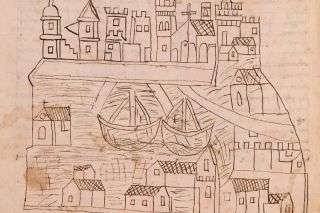
Venice was once home to some of the world’s greatest artists — Michelangelo, Leonardo da Vinci and Titian, to name a few. But the oldest known city view of Venice wasn’t sketched by any of them.
It was sketched by a 14th-century pilgrim.
The pen-made drawing is part of a manuscript written by Niccolò da Poggibonsi, an Italian pilgrim and Franciscan friar who traveled to and from Jerusalem in an adventurous journey from 1346 to 1350. Niccolò passed through Venice during his pilgrimage and was so inspired by the city’s boats, churches and buildings that he scribbled them down and put the drawing in his manuscript.
This roughly 670-year-old drawing was recently discovered by Sandra Toffolo, a postdoctoral researcher of history at the University of St. Andrews in Scotland. Toffolo’s specialty is Venice during the Renaissance. She came across the drawing in May 2019 at the Florence National Central Library while researching her monograph (an in-depth scholarly paper) titled “Describing the City, Describing the State,” which will be published later this year.
“The discovery of this city view has great consequences for our knowledge of depictions of Venice, since it shows that the city of Venice already, from a very early period, held a great fascination for contemporaries,” Toffolo said in a statement.
As soon as she saw the drawing, Toffolo said, she knew that it was the oldest known city view of Venice, excluding maps and portolan, or sailing charts. The oldest map on record of Venice, made by Fra Paolino, a Franciscan friar from Venice, is a few decades older, dating to about 1330. However, to make sure her hunch was correct, Toffolo spent several months verifying that the pilgrim’s drawing is actually the oldest city view of Venice on record.
In addition to the sketch, Niccolò described Venice in his manuscript, which he likely made after he returned to Italy in 1350, Toffolo said.
She also noticed a smattering of pinpricks on the original manuscript, indicating that the sketch was widely circulated. That’s because, when copying images, publishers used to make pinpricks in the paper and then sift powder through the holes, transferring the outline of the image to a new page.
“The presence of these pinpricks is a strong indication that this city view was copied,” Toffolo said. “Indeed, there are several images in manuscripts and early printed books that are clearly based on the image in the manuscript in Florence.”
Sourse: www.livescience.com





